Bipolar Junction Transistors (BJTs) are key in today’s electronics. They work in three main areas: cutoff, active, and saturation. The active region is vital because it allows for linear amplification. This is crucial for making analog circuits.
In the active region, the base-emitter junction is forward-biased, and the base-collector is reverse-biased. This setup helps control how charge carriers move. It makes the transistor a good linear amplifier. This region is important for many uses, like audio amplifiers and radio frequency (RF) circuits.
Key Takeaways
- The active region is a crucial operating mode for Bipolar Junction Transistors (BJTs), enabling linear amplification and signal processing.
- In the active region, the base-emitter junction is forward-biased, and the base-collector junction is reverse-biased, allowing for efficient control of charge carrier transport.
- BJTs in the active region are essential components in a wide range of analog circuits, including audio amplifiers, radio frequency (RF) circuits, and other signal processing applications.
- Understanding the characteristics and parameters of the active region, such as DC beta (βDC) and DC Alpha (αDC), is crucial for designing reliable and efficient BJT-based circuits.
- Proper biasing and load conditions in the active region are essential for optimizing BJT performance and ensuring thermal stability in various applications.
Introduction to Bipolar Junction Transistors (BJTs)
Bipolar Junction Transistors (BJTs) are key in electronic circuits. They act as amplifiers and switches. BJTs have two p-n junctions: the emitter-base junction and the base-collector junction. They come in NPN and PNP types, based on their doping.
Definition and Function of BJTs
A BJT controls charge carrier flow between its terminals: emitter, base, and collector. The emitter sends out charge carriers, and the collector gathers them. The base controls this flow. This design makes BJTs efficient in amplifying and switching signals.
Historical Background of BJTs
William Shockley, John Bardeen, and Walter Brattain invented the BJT in 1948 at Bell Laboratories. This invention changed the electronics world. It led to big steps in amplification and switching.
Structure of BJTs
A BJT has two p-n junctions: the emitter-base junction and the base-collector junction. In an NPN transistor, the emitter and collector are n-type, and the base is p-type. For a PNP transistor, it’s the opposite. This setup lets BJTs control charge carrier flow.
Understanding the BJT Operating Regions
Bipolar Junction Transistors (BJTs) are key semiconductor devices with three main regions: the cutoff region, the saturation region, and the active region. Knowing these regions is vital for designing and using BJTs in electronic circuits.
Overview of BJT Regions
In the cutoff region, both junctions are reverse-biased, leading to little current flow. The BJT is essentially off in this state.
The active region is where the BJT works as a linear amplifier. The emitter-base junction is forward-biased, while the collector-base is reverse-biased. This setup allows for controlled current flow, making it great for signal amplification.
The saturation region happens when both junctions are forward-biased. Here, the BJT acts like a closed switch, with the collector and emitter short-circuited.
Key Differences Among Regions
| Region | Emitter-Base Junction | Collector-Base Junction | Transistor Operation |
|---|---|---|---|
| Cutoff | Reverse-biased | Reverse-biased | Transistor is turned off |
| Active | Forward-biased | Reverse-biased | Transistor acts as a linear amplifier |
| Saturation | Forward-biased | Forward-biased | Transistor acts as a closed switch |
Understanding these regions helps engineers design BJT-based circuits for tasks like amplification, switching, and signal processing.
Characteristics of the Active Region
Bipolar Junction Transistors (BJTs) have special traits in the active region. This region is key for many electronic uses. The base-emitter junction is forward-biased, and the base-collector is reverse-biased. This setup helps control the collector current (IC) with the base current (IB), making amplification possible.
Voltage and Current Relationships
In the active region, the collector current (IC) is directly related to the base current (IB). This is due to the DC current gain (βDC). The formula is IC = βDC * IB. The voltage across the collector-emitter (VCE) stays almost the same for a certain base current. This makes amplification stable and linear.
Load Line Analysis
Load line analysis is vital for understanding BJTs in the active region. It shows how IC and VCE are related. This helps see the transistor’s operating point and how it changes with different loads. It’s key for optimizing the BJT’s performance and ensuring it’s biased right.
Gain in the Active Region
The active region is best for amplification because it offers the highest current gain. The gain, or β, can be 50 to 500 or more. This high gain is crucial for making many analog circuits, like audio amps and RF circuits.
“The active region is the most critical operating mode for BJTs, as it enables the efficient and linear control of the collector current, which is essential for amplification and signal processing applications.”
Importance of the Active Region in Circuit Design
The active region of Bipolar Junction Transistors (BJTs) is key in Electronic Circuit Design and Analog Amplifiers. It makes it possible to amplify signals linearly. This is vital for many analog circuit uses.
Amplification and Signal Processing
In the active region, a small base current change can lead to a big collector current change. This lets BJTs act as linear amplifiers. Their ability to amplify is crucial for handling analog signals in electronic circuits.
Applications in Analog Circuits
BJTs in the active region are used a lot in Analog Amplifiers. These include audio, RF, and operational amplifiers. These circuits need BJTs’ linear amplification to work well.
Impact on Digital Circuits
The active region is important for analog circuits but not for digital ones. In digital circuits, BJTs are used in saturation or cut-off regions. This makes them switch efficiently, aiding in digital signal processing and logic.
“The active region of BJTs allows for linear amplification, a critical function in numerous analog circuit applications.”
Knowing about the active region is vital for BJTs’ performance in designs. This includes Analog Amplifiers and Digital Circuits.
| BJT Region | Description | Typical Application |
|---|---|---|
| Active Region | Both emitter-base and collector-base junctions are forward-biased, allowing for linear amplification. | Analog Amplifiers, Signal Processing |
| Saturation Region | Both emitter-base and collector-base junctions are forward-biased, resulting in the transistor being fully “on” like a closed switch. | Digital Switching, Logic Gates |
| Cut-off Region | Both emitter-base and collector-base junctions are reverse-biased, turning the transistor completely “off” like an open switch. | Digital Switching, Logic Gates |
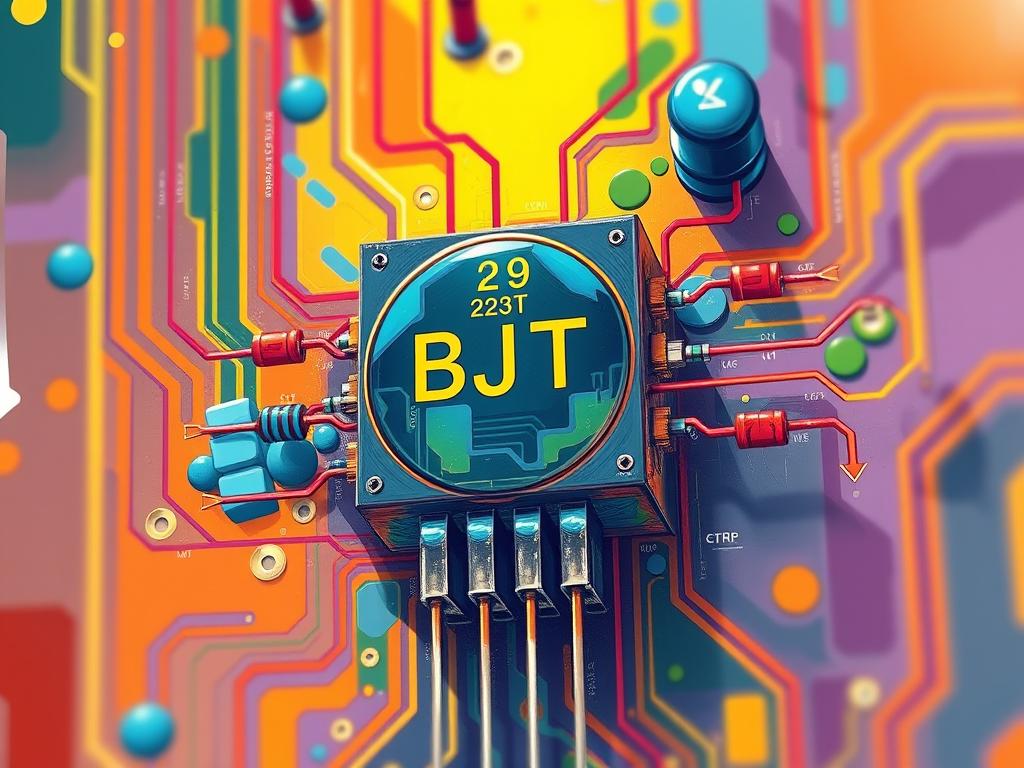
Active Region Load Conditions
Ensuring bipolar junction transistors (BJTs) work well in the active region is key. The DC operating point, found by plotting the DC load line, is crucial. It shows how BJTs behave without any input current.
The DC operating point must be set right for the transistor to work in the active region. Different biasing methods, like fixed base bias and voltage divider bias, affect this point. They help keep the transistor stable and reliable.
Resistive Loads and Their Impact
Resistive loads greatly affect voltage and current in the active region. Looking at the DC load line is important. It helps find the best operating point for any application.
Voltage Divider Biasing
Voltage divider bias is a common method for keeping BJTs in the active region. It uses resistors to create a stable DC operating point. This makes it a top choice for many circuits.
Other Biasing Methods
There are other ways to keep BJTs in the active region, like fixed base bias and collector-feedback bias. Each method has its own benefits and drawbacks. The right choice depends on the circuit’s needs.
Using tools like PSpice Simulator with PCB design software helps a lot. It makes analyzing and improving the DC operating point of transistors easier. This ensures they work well in the active region.
| Biasing Method | Advantages | Disadvantages |
|---|---|---|
| Voltage Divider Bias |
|
|
| Fixed Base Bias |
|
|
| Collector-Feedback Bias |
|
|
In summary, knowing how load conditions and biasing methods affect BJTs is vital. Proper biasing ensures stable operation and the right amplification. It’s crucial for BJTs to work well in the active region.
The Role of Temperature in the Active Region
The performance of bipolar junction transistors (BJTs) in the active region is very sensitive to temperature changes. As temperatures go up, the DC current gain (β) of a BJT usually increases. This can lead to a dangerous situation called thermal runaway.
In thermal runaway, the increase in temperature makes the collector current go up. This in turn makes the temperature rise even more. This creates a loop that can damage the transistor.
Temperature changes also affect the base-emitter voltage (VBE) and leakage currents in BJTs. As temperature goes up, VBE goes down. At the same time, leakage currents increase. These changes can make BJT circuits unstable, especially in high-power applications.
Effects of Temperature on Performance
- Increase in DC current gain (β) with rising temperature, leading to potential thermal runaway
- Decrease in base-emitter voltage (VBE) with increasing temperature
- Rise in leakage currents as temperature increases
Thermal Stability Challenges
Keeping BJT circuits stable at different temperatures is a big challenge. To solve this, designers use proper biasing, heat sinking, and temperature compensation circuits. It’s important to know the temperature coefficients of key BJT parameters to make stable circuits.
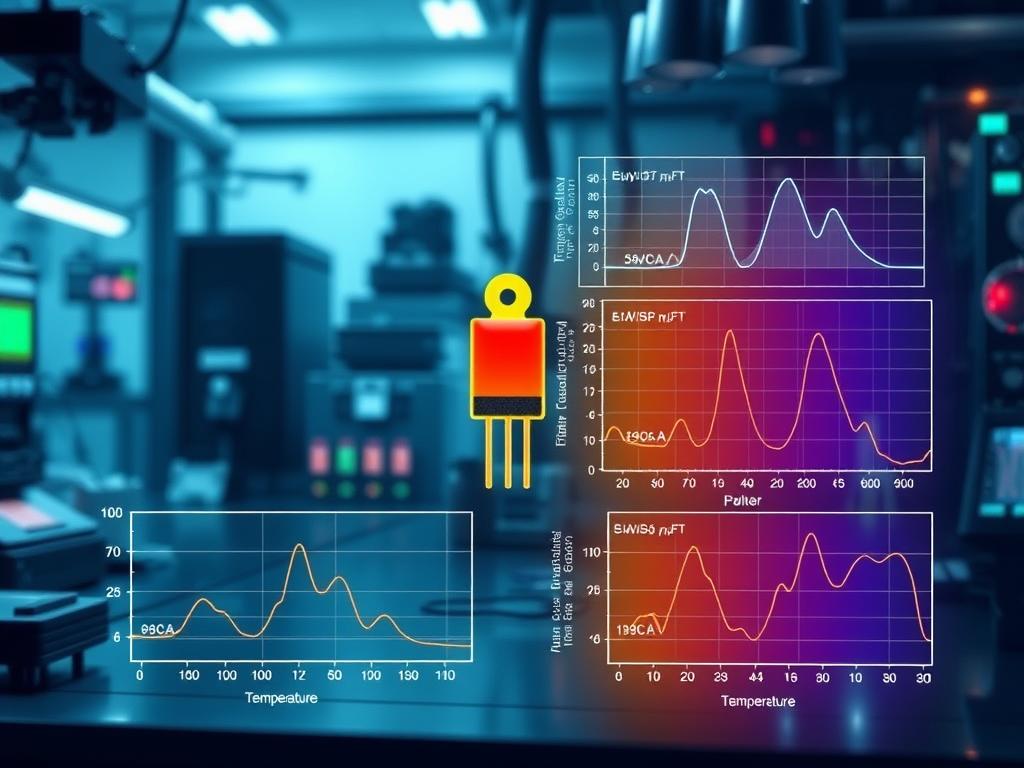
“Designing for thermal stability is crucial in BJT circuits, especially in high-power applications.”
Matching BJTs for Optimal Performance
Choosing the right Bipolar Junction Transistor (BJT) is key for top performance. It’s about matching parameters for efficient signal amplification and power control. This ensures precise circuit operation.
Selecting the Right BJT
Engineers must look at several factors when picking a BJT. They check the current gain, frequency response, and voltage ratings. The current gain, or beta (β), is vital for amplifying signals.
The frequency response, including the transition frequency (fT), is important for high-speed circuits. Voltage ratings, like the maximum collector-emitter voltage (VCEO), ensure the BJT operates safely.
Parameter Matching Techniques
For precise applications, matching BJT parameters is crucial. This means finding transistors with similar current gain and base-emitter voltage (VBE). Matching ensures consistent performance and reduces offset voltages.
Understanding BJT parameters from datasheets is essential. Engineers must also consider temperature effects. Proper thermal management is key for optimal performance.
| Parameter | Significance | Matching Considerations |
|---|---|---|
| Current Gain (β) | Ratio of collector current to base current, critical for amplification and control | Select BJTs with similar current gain values |
| Base-Emitter Voltage (VBE) | Voltage drop across the base-emitter junction, affects biasing and offsets | Choose BJTs with closely matched VBE values |
| Temperature Coefficient | Influence of temperature on BJT characteristics, impacts thermal stability | Match transistors with similar temperature coefficients |
By carefully selecting and matching BJTs, designers achieve optimal performance. This is crucial for a wide range of applications, from amplifiers to power control systems.
Common Applications of BJTs in the Active Region
Bipolar junction transistors (BJTs) are key in many electronic circuits, especially in the active region. This area is vital for tasks like audio amplification, radio frequency (RF) signal processing, and power switching.
Audio Amplification
In audio circuits, BJTs are top-notch amplifiers, offering clear signal reproduction. They work in the active region to amplify audio signals accurately. This makes them essential in audio equipment.
By operating in this region, BJTs can amplify audio waveforms well. This ensures sound is reproduced accurately and with good dynamics.
Radio Frequency Applications
In RF electronics, BJTs are used as amplifiers and oscillators. Their active region is key for amplifying RF signals. This makes them crucial in RF amplifiers for transmitters, receivers, and transceivers.
BJTs can also act as oscillators. They generate stable RF signals for wireless communication systems.
Switching Applications
BJTs are also used as switches in digital circuits, but their active region is vital for analog switching and voltage regulation. In these roles, BJTs act as variable resistors. This allows for controlled current flow and voltage regulation, making them useful in power switching circuits.
BJTs’ versatility in the active region makes them a fundamental part of electronic design. They support a wide range of applications, from amplification to switching and signal processing. As technology advances, BJTs will continue to play a key role in many electronic systems.
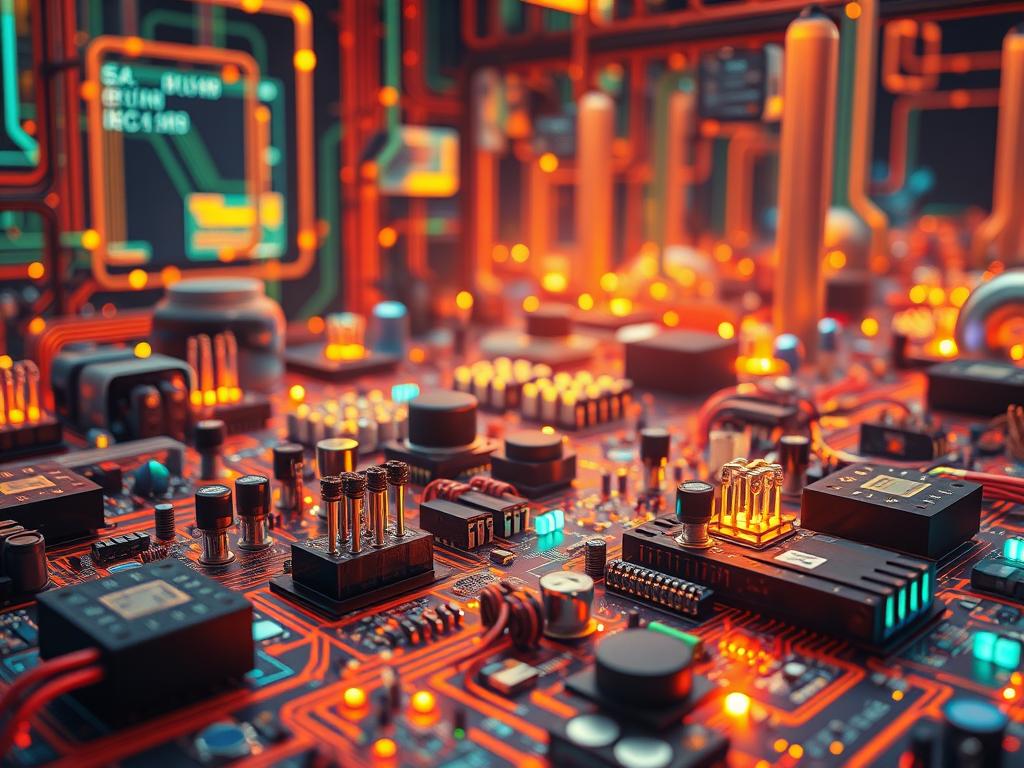
Analyzing BJT Performance in the Active Region
Bipolar Junction Transistors (BJTs) are key in electronic circuit design. Understanding their performance in the active region is vital. This knowledge helps in grasping their small-signal behavior and frequency limitations. It’s important for optimizing circuit performance and meeting design needs.
Understanding DC and AC Analysis
DC analysis sets the BJT’s operating point, showing its steady-state conditions. It uses load line techniques and looks at the BJT’s characteristic curves. AC analysis, however, examines the transistor’s small-signal behavior and frequency response.
Frequency Response of BJTs
The frequency response of BJTs in the active region is affected by parasitic capacitances and transit times. These factors lead to frequency-dependent behavior. This is crucial for high-frequency applications and amplifier design.
“The frequency response of BJTs in the active region is an essential consideration for high-frequency applications, as it determines the device’s ability to amplify signals effectively at different frequencies.”
By combining DC and AC analysis, designers can fully understand BJTs in the active region. This knowledge is key for creating reliable and efficient electronic circuits for today’s needs.
Troubleshooting Issues in the Active Region
BJTs need to work well in the active region for circuits to perform well. But, problems can happen that need fixing. Knowing how to find and fix these issues is key to keeping BJTs working right.
Identifying Common Faults
One big problem is when the base-emitter voltage (VBE) isn’t right. For NPN transistors, it should be about 0.7 volts. For PNP, it’s -0.7 volts. If it’s off, the collector current can change, hurting the circuit’s performance optimization.
Another issue is thermal runaway. This happens when the transistor gets hotter and the current goes up. It makes more heat, starting a cycle that can damage the transistor. This is especially hard to deal with in high-power transistors.
Also, unwanted oscillations can mess up the circuit. These can come from things like extra capacitances or inductive coupling. Finding and fixing these problems takes careful analysis.
Solutions to Active Region Problems
Fixing these problems needs a careful approach to circuit debugging and making things work better. Some important steps include:
- Changing the biasing to get the right VBE and collector-emitter voltage (VCE)
- Using heatsinks or other ways to keep the transistor cool
- Changing the circuit design to avoid problems with extra elements
- Adding feedback or stabilization to make the system more reliable
By knowing what causes these problems and fixing them, engineers can make sure BJTs work their best in the active region.
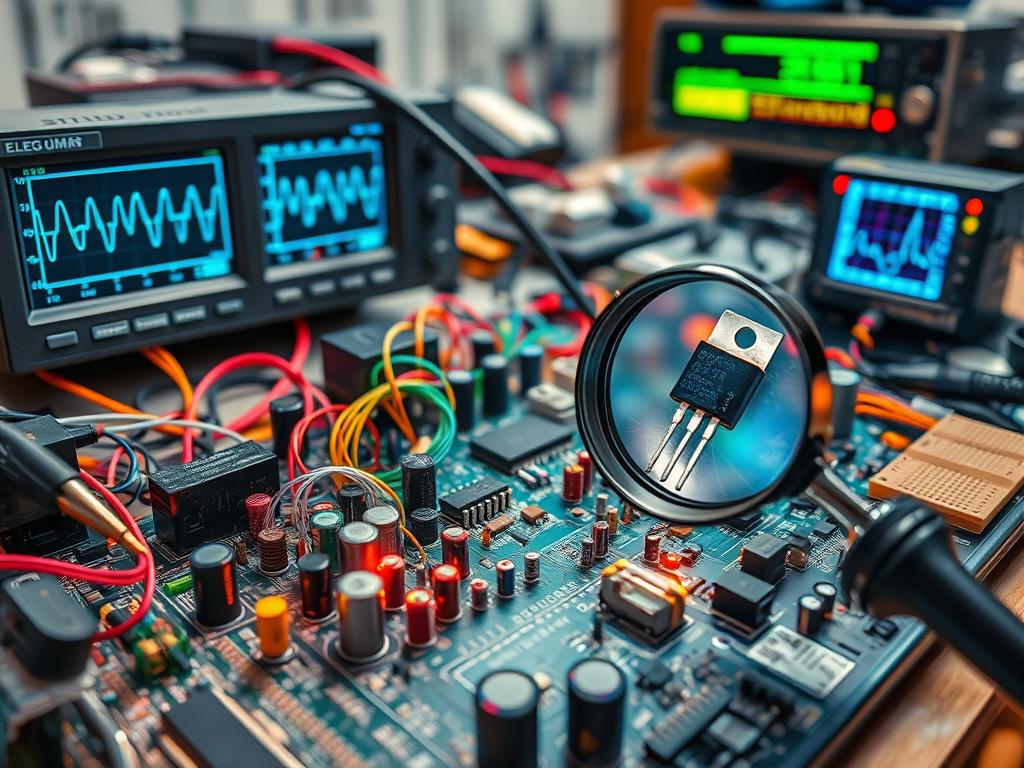
| Fault | Description | Solutions |
|---|---|---|
| Improper Biasing | Deviation from the expected base-emitter voltage (VBE) of 0.7V (NPN) or -0.7V (PNP) | Adjust biasing networks, use voltage dividers or other biasing methods |
| Thermal Runaway | Increase in temperature leading to a rise in collector current and further heat generation | Improve thermal management, use heatsinks or active cooling, monitor temperature |
| Unwanted Oscillations | Disruptive oscillations caused by parasitic elements or circuit topology issues | Redesign circuit topology, use feedback or stabilization techniques |
“Proper biasing and voltage control are crucial to maintaining a BJT in forward active mode for amplification and switching applications.”
Future Trends in BJT Technology
Bipolar Junction Transistors (BJTs) are still key in many areas, even as MOSFETs grow in use. BJTs are important in specific fields. The future will see new semiconductor materials and alternatives to traditional BJTs.
Advances in Semiconductor Materials
New semiconductor materials are being developed. Silicon-germanium (SiGe) and gallium nitride (GaN) are leading the way. They offer higher speed, better thermal management, and enhanced efficiency.
Potential Alternatives to BJTs
MOSFETs are becoming more popular, but BJTs still have their uses. MOSFETs are better for digital circuits because they are more efficient. But BJTs are still great for analog and radio frequency (RF) circuits.
| Characteristic | BJTs | MOSFETs |
|---|---|---|
| Power Handling | High | Moderate |
| Noise Performance | Excellent | Good |
| Frequency Response | High | High |
| Input Impedance | Low | High |
| Output Impedance | Low | High |
The future of BJT technology will be shaped by new materials and designs. By using BJTs’ strengths, we can keep improving electronics.
“The future of BJT technology lies in the seamless integration of advanced materials and innovative circuit designs, empowering engineers to create even more efficient and high-performing electronic systems.”
Comparing BJTs with Other Transistors
Bipolar Junction Transistors (BJTs) and Metal-Oxide-Semiconductor Field-Effect Transistors (MOSFETs) are two different types of transistors. Each has its own strengths and weaknesses. Knowing these differences is key to picking the right transistor for a job.
BJTs vs. MOSFETs
BJTs are great for analog tasks like amplifying signals. They work by controlling current, making small changes in base current lead to big changes in collector current. This makes them good at amplifying signals.
MOSFETs, however, are best for digital circuits. They use less power and are easier to make in dense circuits. MOSFETs are controlled by voltage, so a small change in gate voltage can greatly affect the current flow.
Advantages and Disadvantages
| Characteristic | BJTs | MOSFETs |
|---|---|---|
| Power Consumption | Typically higher | Typically lower |
| Gain | Excellent in the active region | Moderate to good |
| Linearity | Excellent | Moderate |
| Fabrication Complexity | Moderate | Simpler |
| Switching Speed | Moderate | Excellent |
Choosing between BJTs and MOSFETs depends on what you need. BJTs are better for analog tasks because of their high gain and linearity. MOSFETs, on the other hand, are better for digital circuits and high-speed applications.
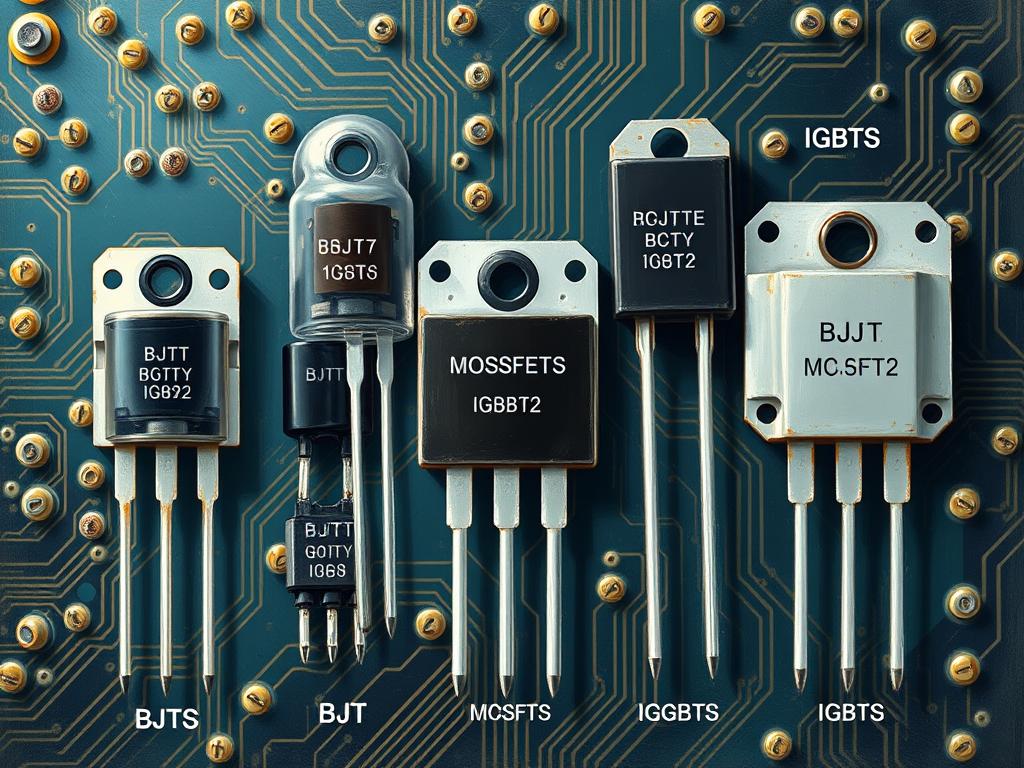
Role of BJTs in Integrated Circuits
Bipolar Junction Transistors (BJTs) are key in making integrated circuits, especially for analog and mixed-signal uses. They are used in many electronic circuits, like audio amps and telecom gear. This is because they are great at amplifying and switching signals.
IC Design Considerations
In IC design, BJTs are used in important parts like bandgap reference circuits, current mirrors, and precise analog stages. Their skill in controlling and boosting electrical signals is vital. Designers must think about BJTs’ special traits to make sure they work well together and reliably.
Challenges in BJT Integration
- Managing parasitic effects: IC making brings parasitic capacitances and resistances that can hurt BJT performance. Designers need to use special layout and design methods to deal with these issues.
- Ensuring uniform device characteristics: It’s important to have BJTs with the same properties in an IC for best performance. But, IC Fabrication and process variations can cause problems.
- Optimizing layout for high-frequency performance: As ICs work at faster speeds, how BJTs are laid out becomes crucial. This is for keeping up with high-speed signal processing and Mixed-Signal Design needs.
Beating these challenges is key to making efficient and dependable integrated circuits. These circuits use BJTs’ special benefits.
Educational Resources for BJT Studies
For those interested in Transistor Theory and Electronics Education, there’s a lot to explore. You can find everything from detailed textbooks to online courses. This makes learning about Bipolar Junction Transistors (BJTs) easier than ever.
Recommended Books on BJTs
“Microelectronic Circuits” by Adel Sedra and Kenneth Smith is a top pick. It goes deep into BJT structure and how they work. Another great choice is “The Art of Electronics” by Paul Horowitz and Winfield Hill. It covers BJT design and circuit use in detail.
Online Resources and Courses
- MIT OpenCourseWare has a detailed Transistor Theory course. It dives deep into BJTs and their uses.
- Khan Academy’s Electronics section has video lessons and simulations. They cover BJT basics well.
- Online forums like Electronics Stack Exchange and EEVblog are great. They’re places where you can ask questions and share ideas on BJT projects.
- Universities and online platforms also offer courses. They teach about semiconductor devices and analog circuit design. This helps you understand BJT theory and use.
Whether you’re a student, engineer, or hobbyist, these resources are key. They help you learn more about Transistor Theory and Electronics Education.
“The more you learn, the more you realize how much you have yet to learn.” – Oprah Winfrey
Conclusion
The active region of Bipolar Junction Transistors (BJTs) is key to their function. It’s vital for making analog circuits and processing signals. Knowing how BJTs work in this region helps engineers use them to their best.
Summary of Key Points
This article has shown how important the active region is for BJTs. It’s crucial for making analog circuits and processing signals. We’ve looked at how voltage, current, and gain work in this region.
The active region is the base for amplifying and processing signals. It’s essential for many electronic uses.
Final Thoughts on BJTs and Their Applications
Even with new technologies like MOSFETs, BJTs are still important. They’re great for analog work because of their high linearity and precision. BJTs are used in many devices, from phones to industrial systems.
As technology gets better, BJTs will keep being useful. Research is looking into new materials and ways to use BJTs. This could open up even more uses for these Transistor Applications.


